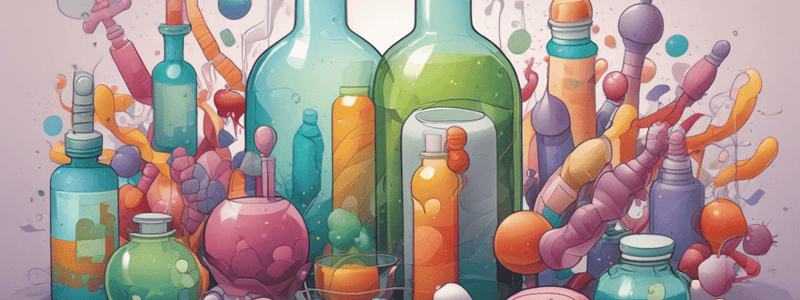Podcast
Questions and Answers
Cephalosporins are grouped into ____ and are all part of the larger class of antibiotics known as _____.
Cephalosporins are grouped into ____ and are all part of the larger class of antibiotics known as _____.
- four generations, beta-lactams
- six generations, macrolides
- three generations, penicillins
- five generations, beta-lactams (correct)
Fifth-generation cephalosporins are effective against which bacterial strain that other cephalosporins are not?
Fifth-generation cephalosporins are effective against which bacterial strain that other cephalosporins are not?
- E. coli
- P. aeruginosa
- C. difficile
- S. aureus (correct)
Use of high doses of which antibiotic has been associated with biliary sludging?
Use of high doses of which antibiotic has been associated with biliary sludging?
- Erythromycin
- Penicillin
- Amoxicillin
- Ceftriaxone (correct)
Which antibiotic is the first choice for treating plague and tularemia?
Which antibiotic is the first choice for treating plague and tularemia?
Aminoglycosides are effective against which type of bacteria?
Aminoglycosides are effective against which type of bacteria?
Streptomycin resistance develops rapidly through which mechanisms?
Streptomycin resistance develops rapidly through which mechanisms?
Which antibiotic is used to treat children with enteritis caused by pathogenic strains of E. coli?
Which antibiotic is used to treat children with enteritis caused by pathogenic strains of E. coli?
Gentamicin and Tobramycin are effective against all the following bacterial types except?
Gentamicin and Tobramycin are effective against all the following bacterial types except?
Flashcards are hidden until you start studying
Study Notes
Cephalosporins
- Cephalosporins are grouped into generations and are part of the larger class of antibiotics known as beta-lactam antibiotics.
Fifth-Generation Cephalosporins
- Fifth-generation cephalosporins have activity against S.aureus strains, unlike other cephalosporins.
Biliary Sludging
- High doses of certain antibiotics have been associated with biliary sludging.
Peptide Synthesis
- Peptide synthesis involves multiple stages, including building and glycosylation.
Sources of Antibiotics
- Antibiotics have various sources, including natural and synthetic sources.
Bacterial Resistance to Antibiotics
- Bacteria have developed different mechanisms to evade the effects of antibiotics, including enzyme production to degrade antibiotics.
Mechanisms of Antibiotic Resistance
- Bacteria can develop resistance to antibiotics through mutations, reducing drug uptake, and producing enzymes to degrade antibiotics.
Treatment of Infections
- Tetracyclen is the first choice for treating plague and tularemia infections.
Aminoglycosides
- Aminoglycosides are bactericidal against gram-negative bacteria, including E.Coli.
Streptomycin Resistance
- Resistance to streptomycin develops rapidly through mutations, reducing drug uptake, and producing enzymes to degrade antibiotics.
Childhood Infections
- In children, Neomycin is used to treat intestinal infections caused by pathogenic E.Coll strains.
Gentamicin and Tobramycin
- Gentamicin and Tobramycin are used to treat most types of bacterial infections, with some exceptions.
Studying That Suits You
Use AI to generate personalized quizzes and flashcards to suit your learning preferences.




